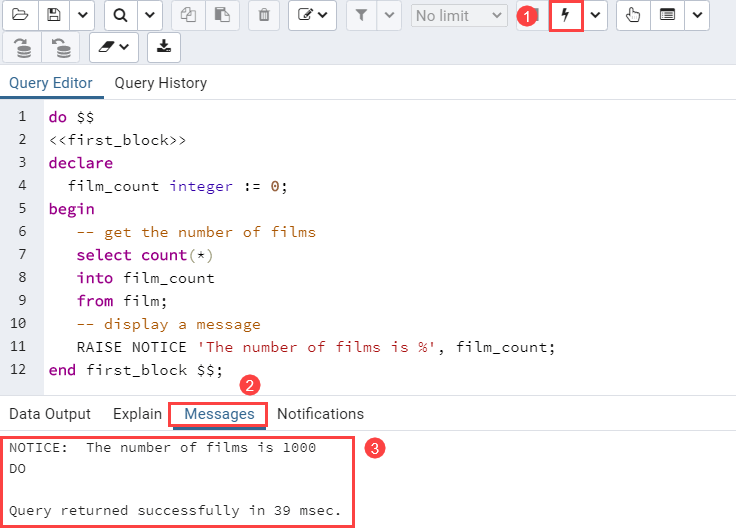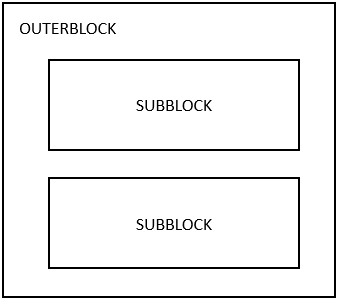Summary: in this tutorial, you will learn about the block structure of PL/pgSQL and how to write and execute your first PL/pgSQL block.
Introduction to PL/pgSQL Block Structure
PL/pgSQL is a block-structured language. Here’s the syntax of a block in PL/pgSQL:
[ <<label>> ]
[ declare
declarations ]
begin
statements;
...
end [ label ];Code language: PostgreSQL SQL dialect and PL/pgSQL (pgsql)Each block has two sections:
- Declaration
- Body
The declaration section is optional whereas the body section is required.
A block may have an optional label that is located at the beginning and end of the block. A block ends with a semicolon (;) after the end keyword.
Typically, you use the block label when you want to specify it in the EXIT statement of the block body or to qualify the names of variables declared in the block.
The declaration section is where you declare all variables used within the body section. Each statement in the declaration section is terminated with a semicolon (;).
The syntax for declaring a variable is as follows:
variable_name type = initial_value;For example, the following declares a variable called counter with the type int and has an initial value of zero:
counter int = 0;Sometimes, you’ll see the := operator instead of = operator. They are have the same meaning:
counter int := 0;The initial value is optional. For example, you can declare a variable called max with the type int like this:
max int;Please note that you’ll learn about variables in more detail in the upcoming variable tutorial.
The body section is where you place the code. Each statement in the body section is terminated with a semicolon (;).
PL/pgSQL block structure example
The following example illustrates a simple block. Because the block has no name, it is called an anonymous block.
do $$
<<first_block>>
declare
film_count integer := 0;
begin
-- get the number of films
select count(*)
into film_count
from film;
-- display a message
raise notice 'The number of films is %', film_count;
end first_block $$;Code language: PostgreSQL SQL dialect and PL/pgSQL (pgsql)Output:
NOTICE: The number of films is 1000
DOCode language: PHP (php)To execute a block from pgAdmin, you click the Execute button as shown in the following picture:

Notice that the DO statement does not belong to the block. It is used to execute an anonymous block. PostgreSQL introduced the DO statement since version 9.0.
The anonymous block has to be surrounded by single quotes like this:
'<<first_block>>
declare
film_count integer := 0;
begin
-- get the number of films
select count(*)
into film_count
from film;
-- display a message
raise notice ''The number of films is %'', film_count;
end first_block';Code language: PostgreSQL SQL dialect and PL/pgSQL (pgsql)However, we use the dollar-quoted string constant syntax to make it more readable.
In the declaration section, we declare a variable film_count and initialize its value to zero.
film_count integer = 0;Code language: PostgreSQL SQL dialect and PL/pgSQL (pgsql)Inside the body section, we use a select into statement with the count() function to retrieve the number of films from the film table and assign it to the film_count variable:
select count(*)
into film_count
from film;Code language: PostgreSQL SQL dialect and PL/pgSQL (pgsql)After that, we show a message using raise notice statement:
raise notice 'The number of films is %', film_count;Code language: PostgreSQL SQL dialect and PL/pgSQL (pgsql)The % is a placeholder that is replaced by the content of the film_count variable.
Note that the first_block label is just for demonstration purposes. It does nothing in this example.
PL/pgSQL Subblocks
PL/pgSQL allows you to place a block inside the body of another block.
The block nested inside another block is called a subblock. The enclosing block, which contains the subblock, is often referred to as the outer block.
The following picture illustrates an outer block and subblocks:

Typically, you divide a large block into smaller, more logical subblocks. The following example illustrates how to use a subblock inside a block:
do
$$
<<outer>>
declare
x int = 0;
begin
x = x + 1;
<<inner>>
declare
y int = 2;
begin
y = y + x;
raise notice 'x=% y=%', x, y;
end inner;
end outer;
$$Code language: PHP (php)Output:
NOTICE: x=1 y=3
DOCode language: PHP (php)In this example, the anonymous block (outer) has a subblock (inner).
In the outer block:
- Declare a variable x and initialize its value to zero.
- Increase the value of x by one in the body.
In the inner block (subblock or nested block):
- Declare a variable y and initialize its value to zero.
- Increase the value of y by x.
- Display the values of the variables x and y using the raise notice.
Summary
- PL/pgSQL is a blocked-structure language that organizes a program into blocks.
- A block contains two parts: declaration and body. The declaration part is optional whereas the body part is mandatory.
- Blocks can be nested. A nested block is a block placed inside the body of another block.